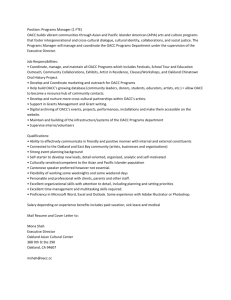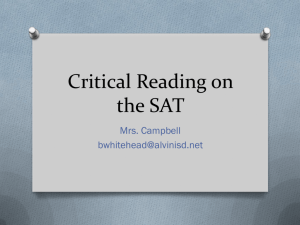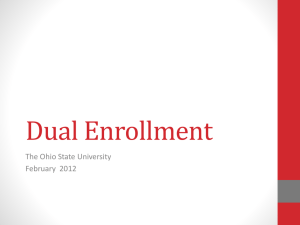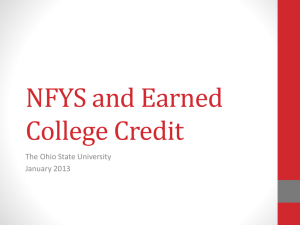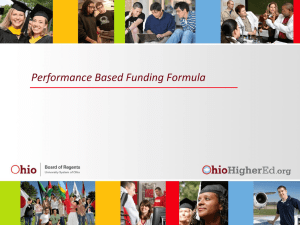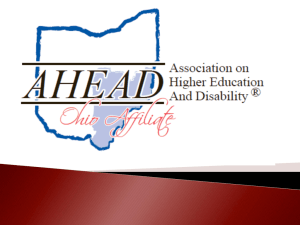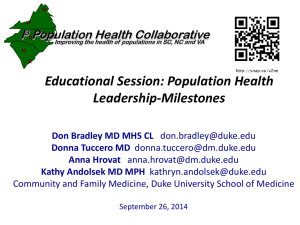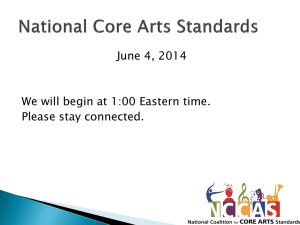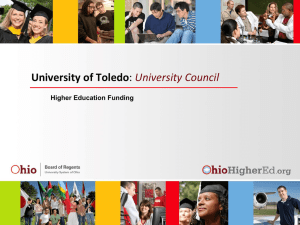Overview of Performance Funding Model for Ohio`s Community
advertisement
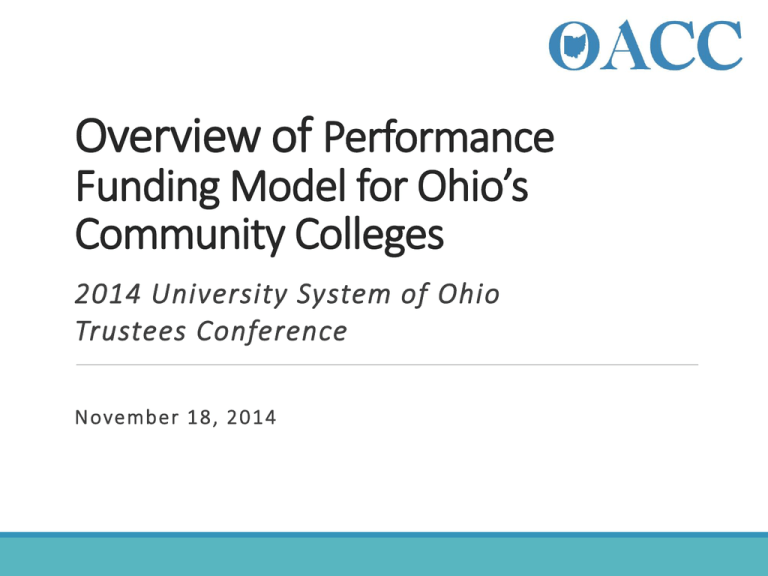
Overview of Performance Funding Model for Ohio’s Community Colleges 2014 University System of Ohio Trustees Conference November 18, 2014 Ohio Higher Education Funding FY 2015 State Share of Instruction (SSI) Universities (14 main campuses plus branches) $1.4 billion Community Colleges (23 campuses) $419 million Total $1.8 billion Performance Funding Major Milestones Sept. 2012 Governor Kasich’s call to recast Ohio’s funding formula for higher education to reward student success and completion Nov. 2012 Ohio Higher Education Commission Funding Recommendations June 2013 House Bill 59 Adopted (FY 2014 – FY 2015 Biennial Budget) • V1 of PBF Model for FY 2014 Dec. 2013 OACC SSI Allocation Recommendations • Transition to 100% PBF model for FY 2015 May 2014 Mid-Biennium Budget Review (MBR) Adopted • V2 of PBF Model for FY 2015 June 2015? Adoption of FY 2016 – FY 2017 Biennial Budget • V3 of PBF Model Performance (Outcomes-Based) Funding Models Completion/ Align state investment with state priorities Drive institutional behavior Attainment Jobs/Economic Development Campus resource allocation Programmatic evaluation and change Alternative delivery models Student Success Agenda & Best Practices Ohio SSI Community College Formula History, 2009-2015 FY 2009-2013 Primarily enrollment-based with inclusion of success points (5% to 10%) Stop Loss (99%-96%) FY 2014 50% enrollment + 25% course completion + 25% success points 97% stop loss FY 2015 Elimination of enrollment component Combination of course completion (50%), success points (25%) & completion metrics (25%) At-risk or access category application No stop loss Background Higher Education Funding Commission report and House Bill 59 charges: At-Risk Factors • …identify the socio-economic, demographic, academic, personal, and other factors that identify a student as being "at-risk" of academic failure…. • study the most appropriate formula weights to: “reward schools that are successful in educating non-traditional and atrisk student populations” Success & Completion Measures • …research the most appropriate success points and completion measures that occur during the academic career of community college students… • Determine how funding shall be distributed among its success points, completion measures and course completion funding… • Requirement to develop institutional completion plans OACC Community College Funding Consultation Process Began meeting in March 2013 • Majority of institutions represented • Included representatives from the Ohio Board of Regents, the Higher Education Funding Commission and the Ohio Office of Budget and Management Facilitated by the OACC and HCM Strategists • Consultation from HCM provided through Lumina Strategy Labs Working group formed in August 2013 • Developed formula framework & technical details • Recommendations presented to full consultation Engagement of OACC Presidents • Presentation and discussion each month from September to December 2013 FY 2015 Proposed Model: Guiding Principles Multiple models were reviewed and evaluated based on data, policy implications, and the consultation’s guiding principles: o Hold true to the mission and priorities of community colleges including access, completion, quality, and workforce development o Incentivize institutions to adopt evidence-based practices to help them succeed o Include metrics grounded in student success research and best practices o Align with state priorities and initiatives o Be simple to understand and communicate o Develop a model that is sustainable, consistent, and reliable FY 2015 Framework Summary Cost-Based Completion Milestones* 25% Success Points 25% *Access Categories Applied Cost-Based Course Completions* 50% All data averaged over three years • Adult (age 25 and over at time of enrollment) • Low-Income, Pell Eligible (ever in college career) • Minority (African American, Hispanic, Native American) Component 1: Course Completion (50%) Cost-Based Calculation • Average statewide cost based on level of course and subject area (aggregation of CIP codes) • # of FTE who pass course * determined cost Access category weight: 15% for any student with one (or more) risk factors Component 2: Success Points (25%) Developmental Education Success • # of Students completing developmental education Math and enrolling in first collegelevel math course (1 point) • # of Students completing developmental education English & enrolling in first collegelevel English course (1 point) 24 Credit Hours • # of students earning first 24 college-level credits (1 point) 12 Credit Hours • # of students earning first 12 college-level credits (1 point) 36 Credit Hours • # of students earning first 36 college-level credits (1 point) Component 3: Completion Milestones (25%) Associate Degree Completions Certificate Completions Transfer w/12+ credit hours Cost-Based Model Access Category Weights: 25% for one access category 66% for two access categories 150% for three access categories Access Categories for Weighting Course Completions and Completion Milestones Colleges submitted suggested populations (15 distinct categories) Aligned with Data or Potential Proxies (9 in total) Data run to determine significance related to graduation and course completion Significance: How much less likely are students from these groups to complete/graduate compared to students not from group Narrow-In: Correlation between factors & policy informed recommended final categories Policy: Focus on student background, not enrollment status (e.g. part-time, enrollment in developmental education courses) FY 15 Access Categories: Adult - 25 and older at enrollment Low-income - Pell-eligible (ever) Minority: American Indian, Hispanic, African American Review of Distribution Method A proportional distribution model for each component is utilized, consistent with prior methods. Institutions receive a proportional share of the total earned across each component. Course Completion (ENTRY) (% of (total cost-based Completed FTE Earned + % of total completed FTE Access Add-on Earned) * 50% of FY 2015 Allocation) Success Points (PROGRESSION/MOMENTUM) (% share success points earned * 25% FY 2015 Allocation) Completion Milestones (COMPLETION) (% of total cost-based completion milestones earned + % of total completion milestones access add-on earned) *25% of FY 2015 Allocation) Fiscal Year 2016-17 Formula Process for FY 2016-17 Work group began meeting again in March 2014 and followed the same process with regular updates to the full consultation and OACC Presidents. A guiding principle of the work for the FY 2016 framework development was to maintain as much consistency as possible from the FY 2015 funding model and support institutions in understanding the formula and evaluating the outcomes. The OACC has engaged HCM Strategists for ongoing facilitation support as well as institutional data analysis. Recommendations for FY 2016-17 Data SSI models have traditionally used projected data for distributions of first-half fiscal year allocations. With inclusion of additional metrics and measures like access populations, projections become more difficult and could result in inaccurate modeling and estimates. Course completions: The model will continue to use most recent three-year average for course completions. This variable relates most directly to enrollment volume, which has direct current cost implications for institutions. Success Points & Completion Milestones: The model will use an additional year lagged three-year average for success points and completion milestones. Projection & Reporting Guidelines: The OACC will work to provide institutions with guidelines and considerations for developing projections for course completions. Recommendations for FY 2016-17, continued Add Academic Preparation Access Category Establish HEI reporting process for placement scores Align to Ohio Remediation Free Standards Short-term certificates and certificates of value Continue to establish common definitions and data collection processes for short-term certificates (less than 1-year) Seek alternative funding stream Next Steps: Evaluate & Refine Additional Policy Issues: Evaluate existing model to understand relation to additional policy priorities and goals. Such as: Course equivalents/Prior Learning Assessment Dual Enrollment Job placement/workforce training Adjusted allocation across components Continuous Improvement & Best Practices Support institutions in the evaluation of student outcomes Identify and share best practices for student success Evaluate and refine the formula to ensure fairness and alignment with statewide priorities and goals Thank You!
